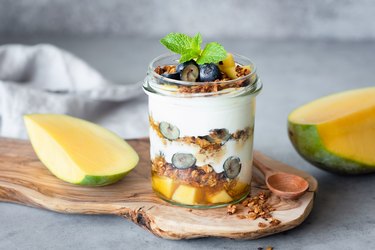
While fruits such as green mangoes are healthy foods, they are also high in natural sugars. If you're curious about raw mango sugar content, consider the glycemic load and glycemic index rating of this fruit.
Read more: Are Mangoes Good for Your Digestive System?
Video of the Day
Video of the Day
Examine Mango Nutrition
According to the USDA, green mango calories clock in at 99 per 1-cup serving. Per cup, mangoes contain around 25 grams of carbohydrates, including 22.5 grams of sugar and 2.6 grams of fiber. Mangoes have a high water content, which accounts for 138 grams of the 165 grams in a cup of mango.
A 1-cup portion also provides 89.1 micrograms of vitamin A — 13 percent of the recommended daily intake for females and 10 percent for males, according to the National Academies of Sciences.
Even more impressive is its vitamin C content — 60.1 micrograms per cup. This provides 80 percent of the recommended daily amount for women and 67 percent for men.
Glycemic Index and Glycemic Load
Although all foods that contain carbohydrates raise blood sugar levels, the effect of carbohydrate-containing foods on blood sugar levels varies.
The glycemic index, or GI, of a particular food indicates the effect it has on blood sugar — specifically how fast the carbohydrates turn to sugar — when compared to the effect of pure glucose on blood sugar.
Foods with a glycemic index of less than 50 are considered to be low-GI foods. A score of 50 to 70 indicates a moderate GI, while foods scoring 70 or above are categorized as high-GI foods.
Glycemic load takes into consideration how much of a carbohydrate is in a particular food, a factor that has a direct bearing on its effect on blood sugar.
Understanding Mango Glycemic Values
Foods with a glycemic load of 10 or less are classified as low-glycemic-load foods. A score of 11 to 19 constitutes a medium glycemic load, while a score of 20 or higher is considered a high glycemic load, according to the Linus Pauling Institute.
According to the international GI database, maintained by the University of Sydney, the glycemic index for 120 grams of mango is 60, which qualifies the fruit as moderate on the glycemic index scale.
However, because green mangoes have a high water content, the amount of carbohydrate by weight makes the glycemic load score 14.8 — using the calculation method presented by the Linus Pauling Institute — making a green mango a low-glycemic-load food.
Read more: 14 Surprising Facts About Mangoes
Make Informed Decisions
Understanding the glycemic index and glycemic load scales for foods such as mangoes can help you choose carbohydrates that have a minimal effect on blood sugar.
Harvard Health Publishing recommends choosing foods that have a low or moderate glycemic load, while limiting foods such as potatoes, refined grains and sweetened beverages that have a high glycemic load.
The glycemic load of foods is only one consideration when you're planning a balanced diet. Consult with your doctor when designing your eating plan, particularly if you have diet-related health problems or are concerned about monitoring your blood sugar levels.
- Linus Pauling Institute: "Glycemic Index and the Glycemic Load"
- University of Sydney: "International GI Database"
- USDA FoodData Central: "Mango, Raw"
- National Academies of Sciences: "Nutrients"
- Harvard Health Publishing: "Glycemic Index for 60+ Foods"
- Harvard School of Public Health: Carbohydrates and the Glycemic Load